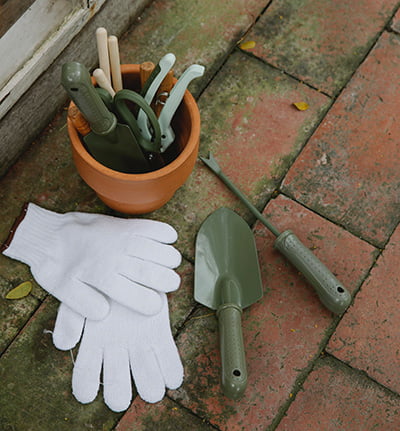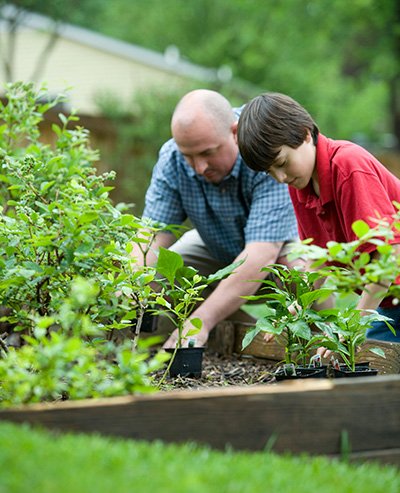Weeds. They are the bane of every gardener's existence. They pop up seemingly out of nowhere and can quickly take over your garden if left unchecked. But fear not, fellow gardeners! With the suitable types of tools and the best weeding tools, you can keep those pesky weeds at bay and maintain a beautiful, healthy garden.
In this article, we will introduce you to some of the most useful and effective types of weeding tools available to help you eliminate weeds in your garden. So grab your gardening gloves and get ready to learn how to tackle those weeds like a pro!
Benefits of using weeding tools
If you're an avid gardener, then you know that weeding is a necessary gardening task. But did you know that using the right weeding tool can make the job much easier? While you can spend time pulling weeds by hand, there are several benefits to using weeding tools in your garden. Here are some of the key benefits
Saves Time and Effort
Weeding tools can make the job of weeding your garden much faster and easier than doing it by hand. You can remove weeds quickly and without stooping or kneeling with the right tool.
Protects Your Plants
Weeding tools are designed to target only the weeds and leave your plants unharmed, so you can remove weeds without damaging your gardening plants.
Prevents Future Weed Growth
Weeding tools can help prevent future weed growth by removing weeds at their roots. This means that you'll spend less time weeding in the long run.
Improves Soil Health
Weeds can compete with your plants for nutrients and water, resulting in poor soil health. By removing weeds, you can improve the health of your soil and promote better plant growth.
Eco-Friendly
Using weeding tools is a more eco-friendly alternative to using chemical herbicides. Removing weeds manually can prevent you from introducing harmful chemicals into your garden.
Cost-Effective
Investing in weeding tools may seem like an added expense, but it can actually save you money in the long run. By preventing weed growth and improving soil health, you may be able to reduce the need for costly fertilizers and other treatments.
Low-Maintenance
Weeding tools require very little maintenance and can last for years with proper care. This means you can enjoy the benefits of using weeding tools for a long time without constantly replacing them.

Source: Pexels
Types Of Weeding Tools
Keeping your garden free of weeds is essential. Not only do they compete with your garden plants for nutrients and water, but they can also be unsightly and overwhelming. Luckily, many weeding tool types are available to help you tackle this task. Here are some of the most effective and popular weeding tools that every gardener should have in their arsenal.
Hand Weeder
A hand weeder is a small, handheld tool designed to remove weeds from the soil with minimal disturbance to the surrounding plants. It typically consists of a long, slender handle and a pointed, fork-like blade that allows you to dig into the soil and remove weeds by the roots. This tool is perfect for removing deeply rooted weeds, especially those with long taproots.
Hori Hori Knife
A Hori Hori knife is a versatile gardening tool that originated in Japan. It is a multi-purpose tool that can be used for digging, cutting, weeding, and planting. It typically consists of a sharp, pointed blade with one serrated edge and one straight edge and a sturdy handle that allows for a comfortable grip.
The sharp and serrated blade of the Hori Hori knife makes it an excellent choice for weeding compacted soil. Its pointed tip can be used to penetrate the soil, and its sharp edge can easily cut through tough weeds.
Weed Torch
A weed torch, also known as a flame weeder, is a tool that uses heat to kill weeds. It typically consists of a long handle with a propane tank attached and a nozzle that releases a flame. The flame heats the weeds to a high temperature, causing them to wilt and die. This type of weeding tool can reach deep into the soil and pull out weeds, while a weed torch can burn weeds and their roots. It is also great for removing weeds from gravel or rocky soil.
Weed Puller
A weed puller, also known as a weeder or weed extractor, is a tool that removes weeds from their roots. It typically consists of a long handle with a grip at one end and a set of prongs or jaws at the other end that grip the weed's root system. When you apply pressure, the prongs or jaws close around the weed's roots, allowing you to pull it out of the ground.
Weed Hoe
A weed hoe, also known as a stirrup hoe or scuffle hoe, is a long-handled garden tool that has a flat blade with a sharp edge. The blade is shaped like a stirrup or a loop, which makes it easy to cut weeds at their base without disturbing the surrounding soil. The weed hoe is used by pushing and pulling it back and forth just below the soil surface, which slices through the weeds and removes them from the ground.
Weed Whacker
A weed whacker, also known as a weed eater or string trimmer, is a handheld garden tool that uses a spinning head with a nylon string to cut weeds and grass. The tool is powered by electricity, gasoline, or a rechargeable battery, depending on the model. Weed whackers are designed to reach areas that are difficult to mow, such as around trees, fences, and other obstacles.

Source: Unsplash
What to Consider When Choosing the Best Weeding Tool
Before buying a weeding tool, here are some of the factors to consider when deciding which weeding tool to add to your garden tool collection:
Type of Weed
The first thing to consider when choosing a weeding tool is the type of weed you're dealing with. Some weeds have shallow roots, while some have a more complex root system. Different weeds have different root structures, so you'll need to choose a tool that can effectively remove the specific type of weed you're dealing with, so you can easily cut through the weed roots.
Garden Size
Another important factor to consider is the size of your garden. If you have a small garden, a handheld weeder may be sufficient. However, if you have a large garden or a lot of weeds to tackle, a long-handled tool may be more efficient.
Handle Length
When it comes to weeding your garden, having the right tool can make all the difference. One factor to consider when choosing a weeding tool is the length of the handle. There are both long and short-handle weeding tools, each with its own advantages and disadvantages.
Long Handle Weeding Tools:
Long-handle weeding tools typically have a handle ranging from 40 to 60 inches. These tools are ideal for weeding large areas or for those who may have difficulty bending or kneeling for long periods. They allow you to pull weeds standing upright, which can be more comfortable and less strenuous on your back and knees.
Some popular types of long-handle weeding tools include the hoe, the cultivator, and the rake. These tools are perfect for breaking up soil and removing stubborn weeds with deep roots, and they're also great for aerating your soil and preparing your garden for planting.
Short Handle Weeding Tools:
Short-handle weeding tools typically have a handle ranging from 8 to 16 inches. These tools are ideal for working in tight spaces or for weeding smaller areas, and they allow you to get up close and personal with your plants and target weeds with precision.
Ease of Use
Weeding can be a tedious and time-consuming task, so it's important to choose a weeding tool that is easy to use and comfortable to hold. Consider the tool's weight, grip, and maneuverability before making your purchase.
Budget
Weeding tools come in a wide range of prices, so it's important to consider your budget before purchasing. While it may be tempting to opt for the cheapest option, keep in mind that a high-quality weeding tool can last for many years and save you time and money in the long run.
Material
When it comes to weeding tools, the material they are made of can significantly affect their performance and durability. Here are the different materials used in weeding tools and their benefits:
Stainless Steel
Stainless steel is a popular choice for weeding tools due to its durability and resistance to rust and corrosion. The stainless steel blade is sharp and long lasting, making them ideal for cutting through tough weeds and roots.
Carbon Steel
Carbon steel is another durable and long-lasting material commonly used in weeding tools. Carbon steel is known for its strength and hardness, making it ideal for digging and cutting through tough soil and weeds.
Aluminum
Aluminum is a lightweight and durable material that is often used in the handles of weeding tools. Aluminum handles are easy to grip and can reduce hand fatigue during extended use.
Plastic
Plastic is a lightweight and affordable material commonly used in weeding tool handles. While plastic handles may not be as durable as those made of metal, they can still provide a comfortable grip and ease of use.
Wood
Wood is a traditional material used in weeding tools, particularly for handles. Wood handles are comfortable to hold and can provide a classic look to your gardening tools. However, wood may not be as durable as metal or plastic and can be susceptible to rot and damage from moisture.
Grip
Weeding can be a tedious and tiring task, and using a weeding tool with a comfortable and secure grip can make all the difference. Here are some of the different types of grips available for weeding tools:
Rubber Grip
A rubber grip is a popular choice for weeding tools because it provides a comfortable and secure hold. Rubber grips can reduce hand fatigue during extended use and provide a non-slip surface even when your hands are wet.
Foam Grip
Foam grips are lightweight and comfortable, making them a good choice for those with hand strength issues. They can also provide insulation against hot or cold temperatures.
Ergonomic Grip
An ergonomic grip is designed to fit the natural contours of your hand, providing maximum comfort and reducing hand fatigue. This type of grip can be particularly beneficial for those who suffer from arthritis or other hand-related conditions.
Textured Grip
A textured grip provides a non-slip surface, making it ideal for use in wet or slippery conditions. It can also provide a comfortable and secure hold, even when wearing gloves.
Wooden Grip
Wooden grips are a traditional choice for weeding tools and can provide a classic look. They can also be comfortable to hold and reduce hand fatigue during use.
